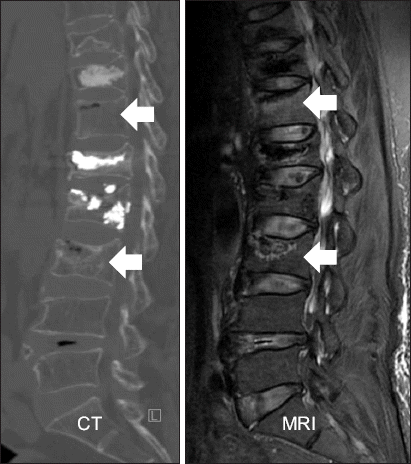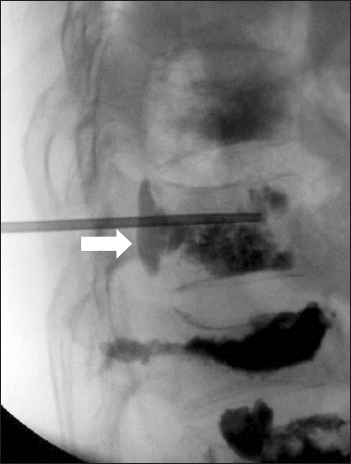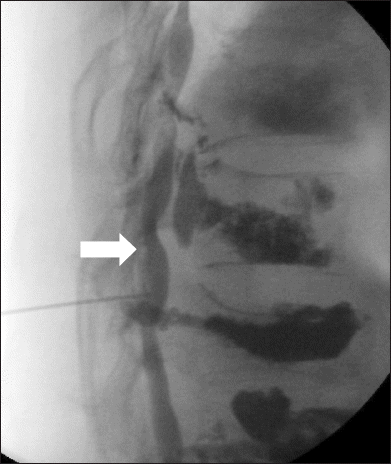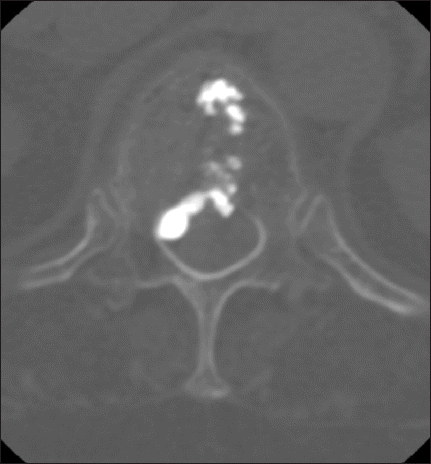Abstract
A 72-year-old woman was diagnosed with Kümmell’s disease of the T12 and L3 vertebrae. During bone cement injection under continuous fluoroscopic guidance, bone cement spread beyond the posterior border of the T12 vertebral body. We halted the injection immediately. A few minutes later, the patient complained of increasing right lower quadrant abdominal pain. This was diagnosed as a preceding sign of neurological complication due to thermal injury. Consequently, we administered an epidural steroid injection, followed by cooled normal saline irrigation through an epidural catheter to minimize and treat the thermal injury. The pain gradually decreased after saline irrigation and completely disappeared after approximately 10 minutes. After completing the percutaneous vertebroplasty, the patient’s lower back pain improved without neurological complications. In conclusion, immediate epidural steroid injection followed by cooled normal saline irrigation through epidural catheterization can be used to treat thermal injury due to bone cement leakage.
Go to : 
Percutaneous vertebroplasty (PVP) is widely performed on patients suffering from painful vertebral compression fractures due to osteoporosis, as well as spinal metastasis of cancer [1,2]. Although it is regarded as a safe and simple minimally invasive procedure, leakage of bone cement (polymethyl methacrylate, PMMA) into the spinal canal occurs more frequently than practitioners may expect [3,4]. Rare but serious neurological complications can result from thermal injury due to bone cement leakage [5,6]. However, even though serious complications are expected, there is no known specific treatment to date. We present a case in which we initially failed to detect bone cement leakage into the spinal canal, and the patient suddenly complained of right lower quadrant (RLQ) abdominal pain that began a few minutes later as the bone cement began to heat. We diagnosed this as a preceding sign of neurological complication by thermal injury due to leakage of bone cement. We immediately administered an epidural steroid injection, followed by cooled normal saline irrigation through an epidural catheter to treat and minimize thermal injury due to bone cement leakage.
Go to : 
A 72-year-old female complained of lower back pain lasting longer than 2 weeks. Except when lying still, her lower back pain was aggravated in any posture and her visual analogue scale (VAS) score was 8 out of 10 when she presented at the hospital. Physical examination revealed local tenderness at the lower thoracic and mid lumbar spinous process areas. Despite admission to appropriate conservative treatment for 2 weeks in another hospital, her lower back pain had not improved. The bone mineral density score was -4.0. Plain film radiographs of the lumbar spine showed previously performed PVP at the T11, L1, and L2 levels. Computed tomography (CT) and magnetic resonance imaging of the lumbar spine revealed a compression fracture with signs of intravertebral vacuum phenomena—characteristic features of Kümmell’s disease—at T12 and L3 (Fig. 1). Therefore, we decided to perform PVP at the levels of T12 and L3.
After sterilizing the affected area, local anesthetic was injected. An 11-gauge PVP needle was introduced through the left pedicle of the T12 vertebral body, under fluoroscopic guidance. After the correct position of the PVP needle was confirmed and the bone cement had reached a toothpaste-like consistency, it was injected under continuous fluoroscopic guidance. No problems were revealed on fluoroscopy until 6 ml of bone cement had been injected. After injecting an additional 2 to 3 ml, I attempted to finish the procedure at the T12 level. This resulted in abnormal fluoroscopic findings. Fluoroscopy revealed that the bone cement had spread beyond the posterior border of the T12 vertebral body, indicating leakage into the spinal canal (Fig. 2). The patient underwent a complete neurological examination immediately, which revealed no abnormalities. This lasted approximately 5 minutes. We monitored the degree of heat generated during hardening of the injected bone cement by palpation. Shortly after completing the neurological examination, the patient suddenly complained of RLQ abdominal pain. For a short time, she complained that her pain was getting worse. We diagnosed this as a preceding sign of neurological complication by thermal injury due to leakage of the bone cement. Although we did not know the exact temperature of the hardening bone cement, the heat generated by the hardening bone cement was sufficient to feel warm to the practitioner, who was wearing surgical gloves on top of lead gloves.
To date, there is no set procedure for cases in which bone cement leaks into the spinal canal. To minimize transmission of the heat generated by the hardening bone cement to the spinal cord and spinal nerve roots, which can cause neurologic complications, an epidural injection of 10 ml, 0.5% lidocaine and 10 mg triamcinolone was administered, immediately followed by epidural catheterization at the T12-L1 level (Fig. 3). A bolus of normal saline was infused every 3 min through the epidural catheter until the practitioner felt no more heat radiating from the fully hardened bone cement. Saline solution was injected until the bone cement completely hardened and the operator could no longer feel any warmth from the bone cement. The pain gradually decreased following the saline injections; after about 10 minutes, the pain had almost completely disappeared. Saline injection through the epidural catheter lasted 30 minutes, after which the RLQ abdominal pain had completely disappeared and the patient showed no neurological abnormalities.
We tried to postpone the PVP at the L3 level, but the patient was insistent that we perform the procedure. Because the patient no longer had any RLQ abdominal pain and was reluctant to return to the operating room on another day, we consented. PVP was safely performed at the level of L3, after which the patient’s lower back pain was improved and her VAS score decreased to 1 or 2 out of 10. Leakage of bone cement into the spinal canal was confirmed via lumbar CT (Fig. 4). The patient was neurologically normal at discharge. She reported no symptoms at a follow-up visit to the outpatient clinic two weeks later. Physical examination revealed no significant neurological findings. Her VAS score was 0 to 1 out of 10. Three months later, there were no complications due to the bone cement leakage.
Go to : 
PVP was first used by Galibert et al. [7] in 1987 to treat a vertebral hemangioma and has since been considered one of the most useful methods of treating osteoporotic compression fractures accompanied by severe pain. However, like most nonconservative treatments, PVP can also cause various adverse effects, such as local tenderness, small hematomas, or bruising at the PVP needle insertion site. More serious complications include direct injury of a vessel, nerve, or the spinal cord by improper PVP needle placement; cement embolism; or neurologic complications caused by extravasation of bone cement [1]. In particular, if bone cement leaks into the spinal canal, the practitioner must be aware of the risk of serious neurologic complications caused by thermal injury due to exothermic cement hardening, as well as a mass effect of the leaked cement [5,6].
Bone cement leakage into the epidural space occurs more frequently than practitioners may expect. In their systematic review of 69 clinical studies, Hulme et al. [8] reported that bone cement leakage occurs in as many as 41% of all PVP cases. In their retrospective study, Ryu et al. [9] reported that PMMA leaked into the epidural space in 92 (26.5%) of 347 treated vertebrae in 64 (40.3%) of 159 patients. Since most epidural leakages are asymptomatic, these cases may go unnoticed. Thus, early recognition of PMMA leakage into the spinal canal can be difficult.
Many practitioners regard PVP under continuous fluoroscopic guidance as simple and safe. However, as previously noted, bone cement leakage into the spinal canal occurs more often than expected. Although most practitioners are aware of the possibility of bone cement leakage into the spinal canal during the bone cement injection period under continuous fluoroscopic guidance, many fail to recognize it for several reasons. First, many practitioners believe that bone cement leakage into the spinal canal is much rarer than it actually is, and they believe they will be able to recognize it immediately under continuous fluoroscopic guidance. Second, the posterior portions of most vertebral bodies are concave in the axial plane; on lateral-view plain film radiographs, the central portion of the posterior vertebral body obscures the most posterior border of the vertebral body. Thus, leakage of bone cement into the spinal canal around the central posterior vertebral body can be almost impossible to recognize initially. Third, many patients who undergo PVP have severe osteoporosis and vertebral deformities, complicating recognition of normal anatomical borders and precluding visualization of bone cement leakage into the spinal canal. Fourth, although the C-arm is almost always used when performing PVP, the images obtained are poorer than those obtained with plain radiography. Furthermore, continuous fluoroscopic guidance is always used during the bone cement injection period, which further decreases the quality of the images. Lastly, most practitioners attempt to perform PVP relatively quickly because there is little time to inject suitable amounts of bone cement before the bone cement hardens. In the current case, the practitioner felt something unusual during injection of the bone cement but still failed to recognize the leakage earlier. In addition, continuous fluoroscopic guidance showed an image overlapped by the pedicle, obscuring the leakage and leading to injection of more bone cement.
Leaked bone cement into the spinal canal can significantly compress the spinal cord, leading to serious neurologic complications. Emergency surgery is often the only option in these cases [1]. Moreover, heat generated during hardening of the PMMA can cause thermal injury, leading to serious adverse effects. Uchiyama et al. [10] reported that temperatures above 45°C caused thermal injury to the spinal cord in animal models. Belkoff and Molloy [5] reported that a peak spinal canal temperature of 35°C to 57°C was recorded in the vertebral bodies, and durations of temperatures > 50°C in the spinal canal ranged from 0 to 2.5 minutes. Recently, in a study performed using an animal model, Lai et al. [6] reported that, following bone cement leakage, the temperature in the posterior cortex reached 59°C and the temperature was maintained above 45°C for more than 5 minutes. The effects of this oversight can be catastrophic, as Wilkes et al. [11] reported a case of paraplegia caused by thermal injury due to PMMA leakage into the spinal canal during PVP.
In the present case, we performed intermittent bolus injection of normal saline every 3 minutes for 30 minutes to treat and minimize thermal injury. The period of 30 minutes was sufficient for the operator to detect no further warmth from the bone cement because the bone cement was completely hardened. Authors with considerable experience performing PVP considered 20 minutes after implantation of bone cement to be sufficient for the bone cement to be completely hardened; during this time, thermal injury must be prevented to avoid complications. The aforementioned studies did not address high temperatures maintained for over 20 minutes. We did not perform continuous infusion despite epidural catheterization because we did not think continuous infusion could provide a sufficient volume of saline to treat and minimize thermal injury.
In fact, it is difficult to conclude that the patient’s RLQ abdominal pain in the present case was necessarily caused by thermal injury due to leakage of the bone cement. The mass effect due to leakage of the bone cement cannot be completely excluded. However, we strongly hypothesize that the patient’s RLQ abdominal pain was caused by thermal injury due to leakage of the bone cement. Although we did not know the exact temperature of the bone cement at the time of RLQ abdominal pain, the patient’s RLQ abdomen pain suddenly started at the time heat was generated during the hardening process of the bone cement, and it gradually disappeared after immediate epidural steroid injection followed by cooled normal saline irrigation through epidural catheterization. As noted earlier, although leakage of bone cement during PVP procedures is very common, there is no recognized treatment to alleviate side effects caused by the leakage of bone cement. In the present case, it was an obvious fault of the practitioner to be unaware of the bone cement leakage earlier. However, it was possible that symptoms thought to be caused by leakage of the bone cement could progress to more serious side effects if left untreated. We performed immediate epidural steroid injection, followed by administration of cooled normal saline irrigation through an epidural catheter to successfully treat and minimize thermal injury due to the leakage of bone cement.
In conclusion, when it is suspected that symptoms may be due to thermal injury caused by leakage of bone cement, epidural steroid injection followed by cooled normal saline irrigation via epidural catheterization can be used to minimize and treat thermal injury.
Go to : 
REFERENCES
1. Anderson SR. Vertebroplasty. Pain Pract. 2001; 1:46–52. DOI: 10.1111/j.1533-2500.2001.01006.x. DOI: 10.1046/j.1533-2500.2001.01006.x. PMID: 17129283.
2. Park JM. Interventional treatments for cancer pain due to bone metastasis. Anesth Pain Med. 2015; 10:149–164. DOI: 10.17085/apm.2015.10.3.149.
3. Yeom JS, Kim WJ, Choy WS, Lee CK, Chang BS, Kang JW. Leakage of cement in percutaneous transpedicular vertebroplasty for painful osteoporotic compression fractures. J Bone Joint Surg Br. 2003; 85:83–9. DOI: 10.1302/0301-620X.85B1.13026. PMID: 12585583.
4. Schmidt R, Cakir B, Mattes T, Wegener M, Puhl W, Richter M. Cement leakage during vertebroplasty: an underestimated problem? Eur Spine J. 2005; 14:466–73. DOI: 10.1007/s00586-004-0839-5. PMID: 15690210. PMCID: PMC3454665.
5. Belkoff SM, Molloy S. Temperature measurement during polymerization of polymethylmethacrylate cement used for vertebroplasty. Spine (Phila Pa 1976). 2003; 28:1555–9. DOI: 10.1097/00007632-200307150-00015.
6. Lai PL, Tai CL, Chen LH, Nien NY. Cement leakage causes potential thermal injury in vertebroplasty. BMC Musculoskelet Disord. 2011; 12:116. DOI: 10.1186/1471-2474-12-116. PMID: 21615939. PMCID: PMC3124425.
7. Galibert P, Deramond H, Rosat P, Le Gars D. Preliminary note on the treatment of vertebral angioma by percutaneous acrylic vertebroplasty. Neurochirurgie. 1987; 33:166–8. PMID: 3600949.
8. Hulme PA, Krebs J, Ferguson SJ, Berlemann U. Vertebroplasty and kyphoplasty: a systematic review of 69 clinical studies. Spine (Phila Pa 1976). 2006; 31:1983–2001. DOI: 10.1097/01.brs.0000229254.89952.6b. PMID: 16924218.
9. Ryu KS, Park CK, Kim MC, Kang JK. Dose-dependent epidural leakage of polymethylmethacrylate after percutaneous vertebroplasty in patients with osteoporotic vertebral compression fractures. J Neurosurg. 2002; 96(1 Suppl):56–61. DOI: 10.3171/spi.2002.96.1.0056.
10. Uchiyama S, Yashiro K, Takahashi H, Homma T. An experimental study of spinal cord evoked potentials and histologic changes following spinal cord heating. Spine (Phila Pa 1976). 1989; 14:1215–9. DOI: 10.1097/00007632-198911000-00014.
11. Wilkes RA, Mackinnon JG, Thomas WG. Neurological deterioration after cement injection into a vertebral body. J Bone Joint Surg Br. 1994; 76:155. DOI: 10.1302/0301-620X.76B1.8300663. PMID: 8300663.
Go to : 




 PDF
PDF Citation
Citation Print
Print







 XML Download
XML Download